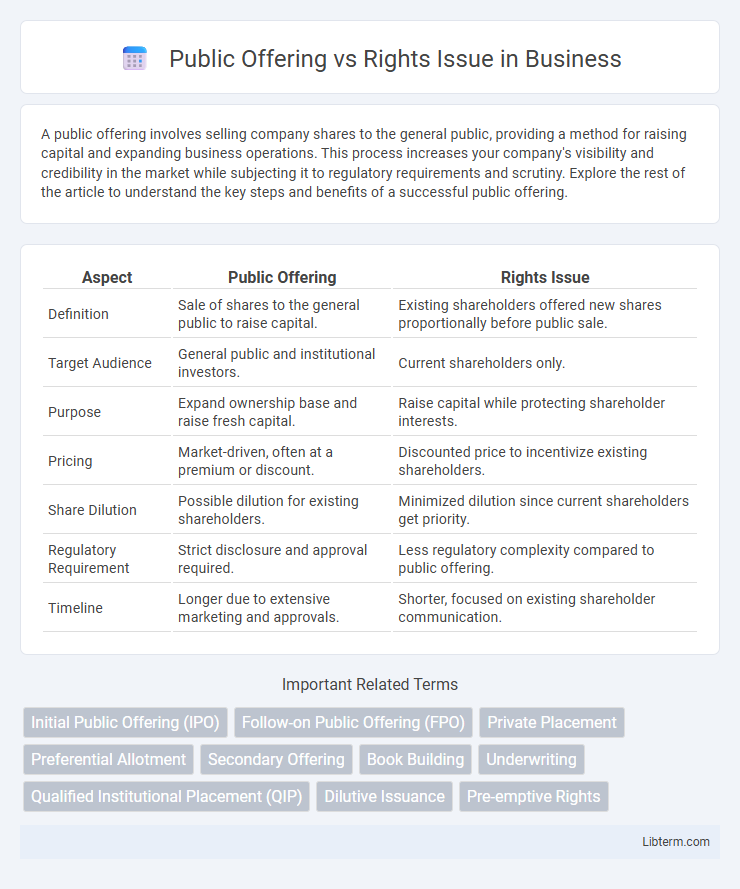A public offering involves selling company shares to the general public, providing a method for raising capital and expanding business operations. This process increases your company's visibility and credibility in the market while subjecting it to regulatory requirements and scrutiny. Explore the rest of the article to understand the key steps and benefits of a successful public offering.
Table of Comparison
| Aspect | Public Offering | Rights Issue |
|---|---|---|
| Definition | Sale of shares to the general public to raise capital. | Existing shareholders offered new shares proportionally before public sale. |
| Target Audience | General public and institutional investors. | Current shareholders only. |
| Purpose | Expand ownership base and raise fresh capital. | Raise capital while protecting shareholder interests. |
| Pricing | Market-driven, often at a premium or discount. | Discounted price to incentivize existing shareholders. |
| Share Dilution | Possible dilution for existing shareholders. | Minimized dilution since current shareholders get priority. |
| Regulatory Requirement | Strict disclosure and approval required. | Less regulatory complexity compared to public offering. |
| Timeline | Longer due to extensive marketing and approvals. | Shorter, focused on existing shareholder communication. |
Understanding Public Offering and Rights Issue
A public offering involves selling shares to the general public through the stock market, allowing companies to raise capital from a broad investor base. A rights issue grants existing shareholders the privilege to purchase additional shares, usually at a discounted price, preserving their ownership percentage. Both methods serve as crucial tools for companies to increase equity, but rights issues prioritize shareholder retention while public offerings target wider market participation.
Key Differences Between Public Offering and Rights Issue
Public Offering involves selling new shares to the general public to raise capital, whereas Rights Issue grants existing shareholders the option to purchase additional shares, often at a discount. Public Offerings dilute ownership by introducing new investors, while Rights Issues maintain proportional ownership among current shareholders. Public Offerings are typically used for expanding shareholder base and market visibility, whereas Rights Issues focus on raising capital quickly from loyal investors.
Purpose and Objectives of Public Offering
Public offerings aim to raise capital from the general public by issuing new shares, enabling companies to finance expansion, reduce debt, or invest in new projects. The primary objective is to enhance liquidity and broaden the shareholder base, facilitating access to public equity markets. Unlike rights issues that target existing shareholders, public offerings seek to attract external investors to support long-term corporate growth strategies.
Purpose and Objectives of Rights Issue
Rights issues primarily aim to raise capital by offering existing shareholders the opportunity to purchase additional shares at a discounted price, ensuring shareholder value preservation. This method enables companies to strengthen their equity base to finance expansion, pay down debt, or improve working capital without diluting current ownership disproportionately. In contrast, public offerings target a broader investor base to increase capital infusion and market visibility, often involving new investors beyond the current shareholder group.
Eligibility Criteria for Investors
Eligibility criteria for public offerings typically include retail investors, institutional investors, and qualified buyers complying with regulatory frameworks such as the SEC in the U.S. Rights issues restrict eligibility primarily to existing shareholders, allowing them to purchase additional shares in proportion to their existing holdings. Public offerings tend to have broader investor eligibility, while rights issues focus on maintaining current ownership structure by giving preferential subscription rights to existing investors.
Process and Timeline Comparison
A public offering involves the company offering new shares to the general public, typically following regulatory approval, with a process that can span several months including underwriting, marketing, and pricing phases. In contrast, a rights issue allows existing shareholders to purchase additional shares at a discounted price within a shorter timeframe, often completed in a few weeks after announcing the offer. The timeline for a public offering generally extends from three to six months due to extensive due diligence and roadshows, while rights issues prioritize faster capital raising with a typical duration of two to four weeks.
Impact on Shareholder Value
A public offering typically dilutes existing shareholders' equity as new shares are issued to the public, potentially lowering the share price but raising capital for growth and expansion. In contrast, a rights issue offers existing shareholders the opportunity to buy additional shares at a discount, preserving or enhancing shareholder value by allowing participation without dilution if fully subscribed. The impact on shareholder value depends on factors such as the issue price, use of proceeds, and investor confidence in the company's future prospects.
Advantages of Public Offering
Public offering broadens investor access by allowing shares to be purchased by the general public, increasing liquidity and potentially enhancing the company's market visibility. It enables companies to raise substantial capital quickly without requiring existing shareholders' approval, fostering growth and expansion opportunities. Public offerings also support diversified ownership, reducing dependence on a limited group of investors and improving market perception.
Advantages of Rights Issue
Rights issues offer companies the advantage of raising capital efficiently by providing existing shareholders the opportunity to purchase additional shares, thereby minimizing dilution of ownership. This method ensures a higher probability of subscription since it targets committed investors familiar with the company's prospects. Furthermore, rights issues often involve lower underwriting fees compared to public offerings, reducing overall capital raising costs.
Choosing the Right Fundraising Method
Choosing the right fundraising method depends on the company's goals and shareholder structure, with public offerings offering access to a broader investor base and greater capital potential, while rights issues allow existing shareholders to maintain proportional ownership. Public offerings involve issuing new shares to the general public, often requiring extensive regulatory compliance and marketing efforts. Rights issues are typically faster and less costly, providing discounted shares to current shareholders, which helps preserve control but may limit capital raised compared to public offerings.
Public Offering Infographic

 libterm.com
libterm.com